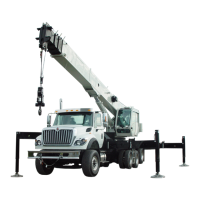NBT50 OPERATOR MANUAL CONTROLS AND OPERATING PROCEDURES
National Crane Published 03-23-2018 Control # 243-14 3-23
STANDARD REMOTE CONTROL
The National Crane model NBT50 is equipped with a
standard hand held radio remote control. An optional remote
control and remote receiver are available and is mounted on
the right side of the crane turret. The standard remote control
is designed for use in setup and tear down of the machine at
the job site.
If your crane is equipped with the optional Full Crane
Remote Control (large dark blue remote control supplied with
a waist strap) see the Radio Remote Options manual for
operating instructions.
The standard Remote Control (1, Figure 3-15) is a palm size
remote control and is shipped with each crane as standard
equipment. This remote control has limited functions as
described in the following information; it does not allow full
remote control of the crane.
The standard remote control (1, Figure 3-15) operates the
main hoist up/down, aux hoist up/down and single front
outrigger (if equipped).
The standard Remote (1, Figure 3-15) and its stowage
bracket are secured to the load chart binder bracket (2).
Batteries
If the standard remote control is not used for a long period, it
is recommended, if using rechargeable batteries, that they
be charged before using the remote control.
When the standard Remote Control (1) is in the stowed
position as shown in Figure 3-15 the remote control power
cord (3, Figure 3-15) should be plugged into the remote
control stow bracket and the other end into the 12V
receptacle (1, Figure 3-16) on the cab control panel. This will
keep the two AA rechargeable batteries used, to power the
Remote Control, charged.
Access the batteries by removing the battery compartment
screw on the back of the Remote Control.
When the ‘L’ flashes on the Remote Control Display (1,
Figure 3-17) the batteries are low and should be replaced
immediately.
CAUTION
Do not store the battery in your pocket. Metal objects can
short the battery and cause burns.
CAUTION
Rechargeable batteries (NiMH or NiCd) must be fully
charged before first use! Never attempt to charge
standard non-rechargeable batteries!

